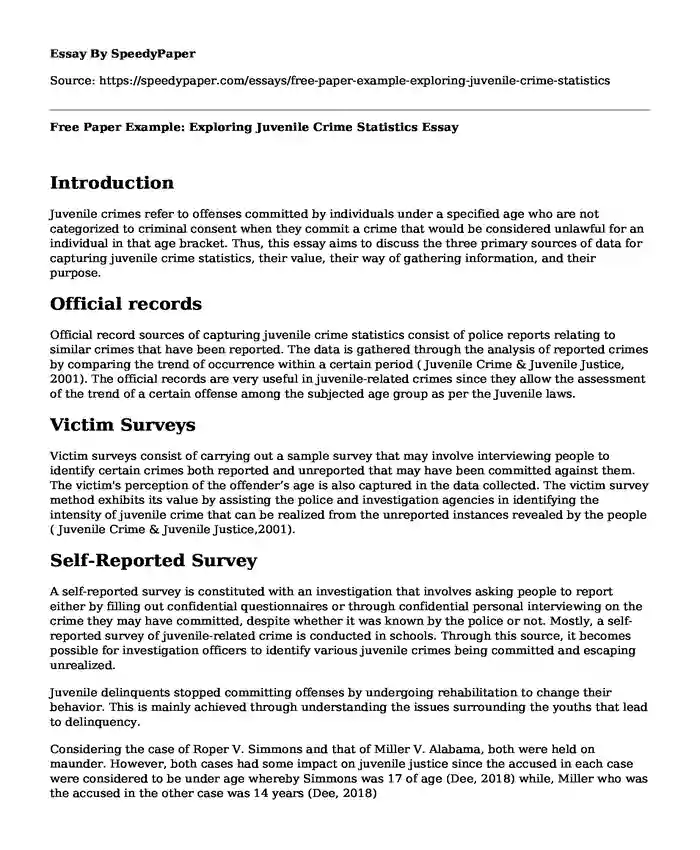
| Type of paper: | Essay |
| Categories: | Law Statistics Juvenile justice |
| Pages: | 2 |
| Wordcount: | 429 words |
Introduction
Juvenile crimes refer to offenses committed by individuals under a specified age who are not categorized to criminal consent when they commit a crime that would be considered unlawful for an individual in that age bracket. Thus, this essay aims to discuss the three primary sources of data for capturing juvenile crime statistics, their value, their way of gathering information, and their purpose.
Official records
Official record sources of capturing juvenile crime statistics consist of police reports relating to similar crimes that have been reported. The data is gathered through the analysis of reported crimes by comparing the trend of occurrence within a certain period ( Juvenile Crime & Juvenile Justice, 2001). The official records are very useful in juvenile-related crimes since they allow the assessment of the trend of a certain offense among the subjected age group as per the Juvenile laws.
Victim Surveys
Victim surveys consist of carrying out a sample survey that may involve interviewing people to identify certain crimes both reported and unreported that may have been committed against them. The victim's perception of the offender’s age is also captured in the data collected. The victim survey method exhibits its value by assisting the police and investigation agencies in identifying the intensity of juvenile crime that can be realized from the unreported instances revealed by the people ( Juvenile Crime & Juvenile Justice,2001).
Self-Reported Survey
A self-reported survey is constituted with an investigation that involves asking people to report either by filling out confidential questionnaires or through confidential personal interviewing on the crime they may have committed, despite whether it was known by the police or not. Mostly, a self-reported survey of juvenile-related crime is conducted in schools. Through this source, it becomes possible for investigation officers to identify various juvenile crimes being committed and escaping unrealized.
Juvenile delinquents stopped committing offenses by undergoing rehabilitation to change their behavior. This is mainly achieved through understanding the issues surrounding the youths that lead to delinquency.
Considering the case of Roper V. Simmons and that of Miller V. Alabama, both were held on maunder. However, both cases had some impact on juvenile justice since the accused in each case were considered to be under age whereby Simmons was 17 of age (Dee, 2018) while, Miller who was the accused in the other case was 14 years (Dee, 2018)
References
Dee, J. (2018). Juveniles and Criminal Culpability: A Research Guide. Retrieved from https://law.tamu.libguides.com/c.php?g=744762&p=5333317
Juvenile Crime, Juvenile Justice (2001). Patterns and Trends in Juvenile Crime and Juvenile Justice. Retrieved from https://www.nap.edu/read/9747/chapter/4#27
Cite this page
Free Paper Example: Exploring Juvenile Crime Statistics. (2023, Dec 11). Retrieved from https://speedypaper.net/essays/free-paper-example-exploring-juvenile-crime-statistics
Request Removal
If you are the original author of this essay and no longer wish to have it published on the SpeedyPaper website, please click below to request its removal:
- A-Worthy Amazon SWOT Analysis Paper Sample
- Essay Example: Description of a Court Room Observation
- What is one possible reason for kidney failure? Free Essay
- Effects of the US-China Trade War on Russia. Essay Sample
- Essay Sample on Definition of Computer Crime and Cybercrime
- Forensic Crime Scene: Attain Warrants, Record, Preserve Evidence - Paper Example
- Paper Sample on Mexican Drug Trafficking Organizations
Popular categories




